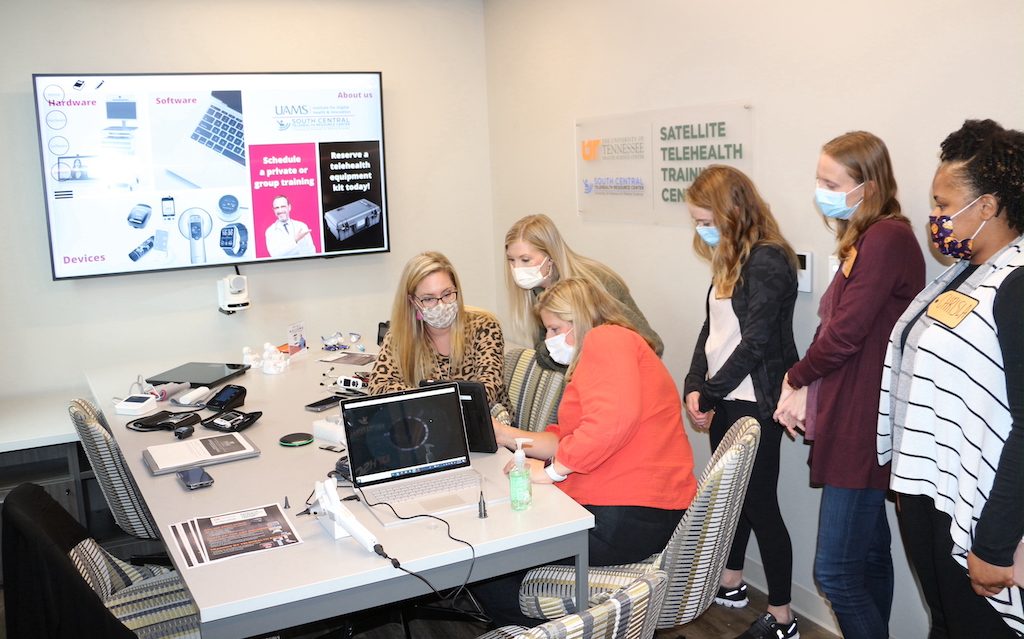
The University of Tennessee Health Science Center’s College of Nursing has been selected as the first satellite telehealth training center in Tennessee by the South Central Telehealth Resource Center.
The new training center, scheduled to open in January, will offer a much-needed resource to train health care providers in telehealth services, which have grown exponentially since the beginning of the COVID-19 pandemic. The presence of the center in the college will also allow faculty members to include telehealth in the curriculum for nursing and nurse practitioner students.
“We will be able to integrate telehealth training into their program of study and provide students the skills to use telehealth to care for their patients in the future,” said Sarah Rhoads, PhD, DNP, WHNP-BC, FAAN, a professor in the UTHSC College of Nursing.
The South Central Telehealth Resource Center, headquartered at the University of Arkansas for Medical Sciences in Little Rock, is part of the National Consortium of Telehealth Resource Centers. The consortium is a collaborative of 12 regional and two national Telehealth Resource Centers committed to implementing telehealth programs for rural and underserved communities. Funded by the U.S Health Resources and Services Administration (HRSA), the resource center provides telehealth training in Arkansas, Tennessee, and Mississippi.
A sub-award to the college from the South Central Telehealth Resource Center will provide the new telehealth training center at UTHSC with a telemedicine cart, including peripheral devices such as stethoscopes, otoscopes, ophthalmoscopes, dermatological and dental cameras. In addition, there will be interactive modules displayed on tablets and remote patient monitoring equipment, such as blood pressure cuffs, scales, pulse oximeters, and glucometers.
The use of telehealth has increased dramatically since the pandemic began, according to a study published in March in the Journal of the American Medical Association Open Network that looked at a cohort of 36 million people in the U.S. During the first four months of the pandemic, telehealth visits accounted for 23.6% of all interactions – compared with 0.3% of contacts for the same timeframe in 2019.
The primary use for telehealth visits continues to be mental health, according to the monthly telehealth regional tracker at FAIR Health, a nonprofit organization that tracks commercial insurance claims as part of a health care cost transparency initiative. In March, 57% of telehealth visits in the U.S. were for mental health care.
“It’s critical that we continue to increase access to health care in rural and underserved communities through digital health,” said Hari Eswaran, PhD, director of the South Central Telehealth Resource Center. “In order to ensure that patients receive the best possible care through virtual platforms, it starts with provider training. The UTHSC Telehealth Training Center will give health care and technology students the necessary resources and best-practice guidelines to implement the use of digital health in their respective health care settings. We’re excited to support the innovative training initiatives by UTHSC to support health care professional education.”
“Telehealth training is vital,” Dr. Rhoads said. “Some health systems had a broad infrastructure and could deploy telehealth easily during the pandemic, while other clinics have struggled to implement telehealth – even a year later.”
UTHSC College of Nursing Dean Wendy Likes, PhD, DNSc, APRN-Bc, FAANP, said, “Telehealth has the potential to improve the quality of health care, increase clinical workflow efficiency and make health care accessible to more people. This is a great opportunity to train health care providers in the use of innovative technology to enhance care using state-of-the-art equipment housed right here in the College of Nursing
